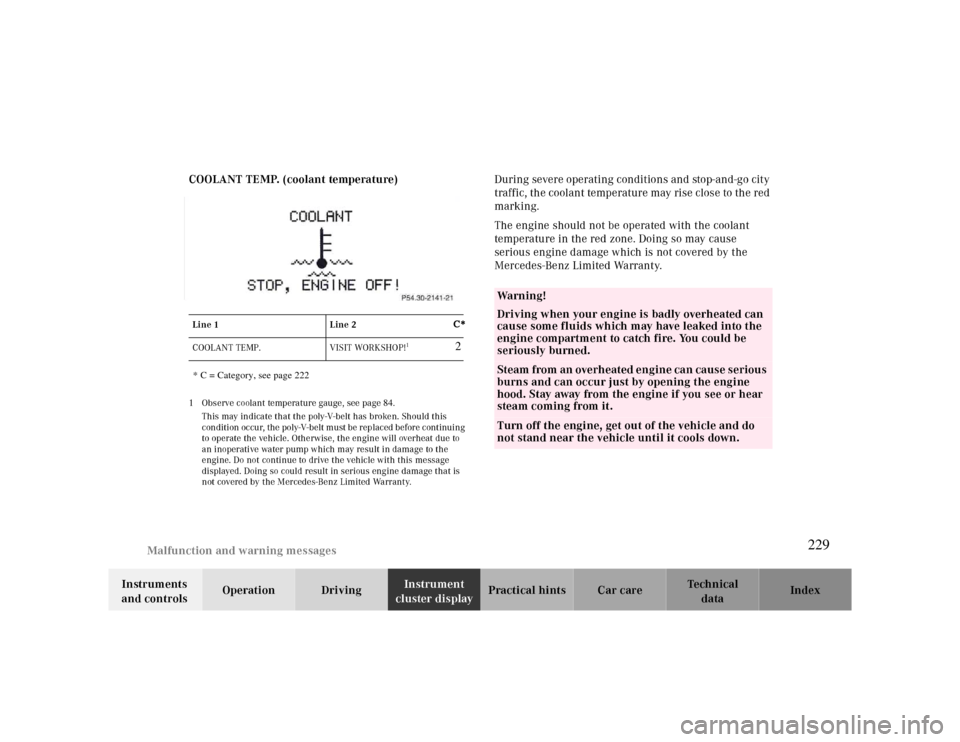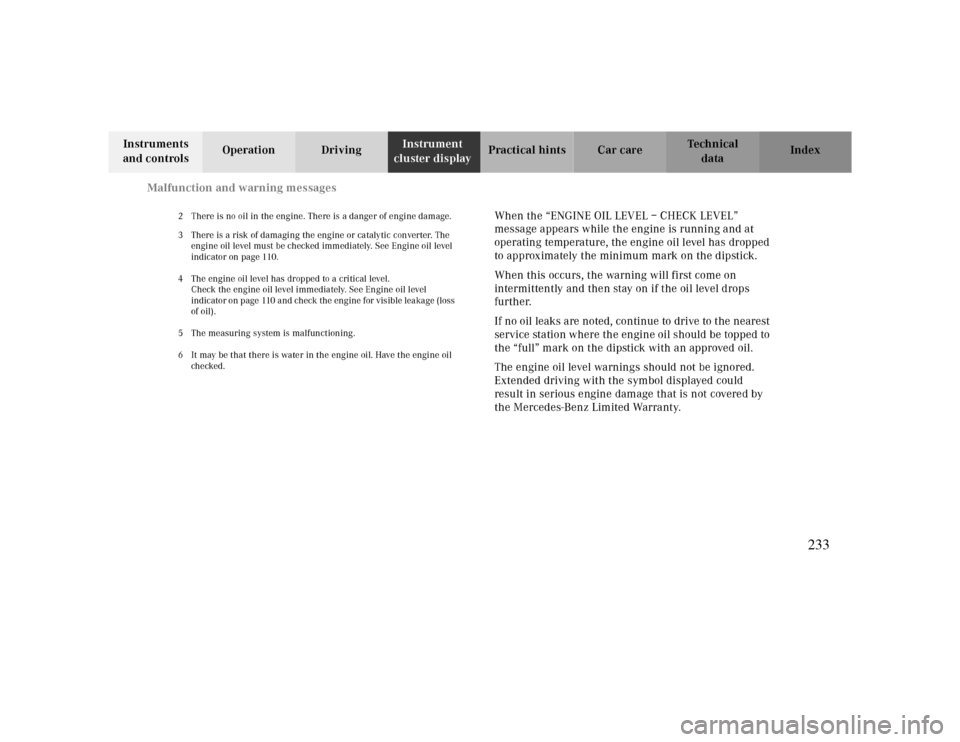Page 229 of 323

Malfunction and warning messages
Te ch n ica l
data Instruments
and controlsOperation DrivingInstrument
cluster displayPractical hints Car care Index COOLANT TEMP. (coolant temperature)
1 Observe coolant temperature gauge, see page 84.
This may indicate that the poly-V-belt has broken. Should this
condition occur, the poly-V-belt must be replaced before continuing
to operate the vehicle. Otherwise, the engine will overheat due to
an inoperative water pump which may result in damage to the
engine. Do not continue to drive the vehicle with this message
displayed. Doing so could result in serious engine damage that is
not covered by the Mercedes-Benz Limited Warranty.
During severe operating conditions and stop-and-go city
traffic, the coolant temperature may rise close to the red
marking.
The engine should not be operated with the coolant
temperature in the red zone. Doing so may cause
serious engine damage which is not covered by the
Mercedes-Benz Limited Warranty.
Line 1 Line 2
COOLANT TEMP. VISIT WORKSHOP!
1
Wa r n i n g !
Driving when your engine is badly overheated can
cause some fluids which may have leaked into the
engine compartment to catch fire. You could be
seriously burned.Steam from an overheated engine can cause serious
burns and can occur just by opening the engine
hood. Stay away from the engine if you see or hear
steam coming from it.Turn off the engine, get out of the vehicle and do
not stand near the vehicle until it cools down. 2
C*
* C = Category, see page 222
229
Page 230 of 323
Malfunction and warning messages
Te ch n ica l
data Instruments
and controlsOperation DrivingInstrument
cluster displayPractical hints Car care Index
LIGHTING SYSTEMWhen the message appears after starting the engine, or
if it comes on while driving, this indicates a failure in
the parking lamp, taillamp, stop lamp, or low beam
headlamp. See page 269 for instructions on replacing
bulbs.
If an exterior lamp fails, the message will appear only
when that lamp is switched on.
If a brake lamp fails, the message will appear when
applying the brake and stays on until the engine is
turned off.
Note:
If additional lighting is installed (e.g. auxiliary
headlamps etc.) be certain to connect into the fuse
before the failure indicator monitoring unit order to
avoid damaging the system.
Line 1 Line 2
LAMP DEFECTIVE CHECK LAMPS!
DISPLAY DEFECTIVE VISIT WORKSHOP!
2 C*
* C = Category, see page 2222
230
Page 232 of 323
Malfunction and warning messages
Te ch n ica l
data Instruments
and controlsOperation DrivingInstrument
cluster displayPractical hints Car care Index
ENGINE OIL LEVEL
1 The engine oil level must be checked immediately. See Engine oil
level indicator on page110 Line 1 Line 2
ENGINE OIL LEVEL CHECK LEVEL!
1
ENGINE OIL LEVEL STOP, ENGINE OFF!
2
ENGINE OIL LEVEL REDUCE OIL LEVEL!
3
ENGINE OIL LEVEL VISIT WORKSHOP!
4
ENGINE OIL SENSOR VISIT WORKSHOP!
5
ENGINE OIL VISIT WORKSHOP!
6
2 C*2
2
2
2 1
OIL TEMP. (engine oil temperature)
There is a danger of engine damage - change to a higher
Check the engine oil level as soon as the vehicle returns
to operating temperature. See Engine oil level indicator
on the page 110. gear or reduce road speed.Line 1 Line 2OIL TEMP. TOO HIGH REDUCE REVS.!
* C = Category, see page 222 * C = Category, see page 222
2 C*
232
Page 233 of 323

Malfunction and warning messages
Te ch n ica l
data Instruments
and controlsOperation DrivingInstrument
cluster displayPractical hints Car care Index
2 There is no oil in the engine. There is a danger of engine damage.
3 There is a risk of damaging the engine or catalytic converter. The
engine oil level must be checked immediately. See Engine oil level
indicator on page110.
4 The engine oil level has dropped to a critical level.
Check the engine oil level immediately. See Engine oil level
indicator on page110 and check the engine for visible leakage (loss
of oil).
5 The measuring system is malfunctioning.
6 It may be that there is water in the engine oil. Have the engine oil
che cked.
When the “ENGINE OIL LEVEL – CHECK LEVEL”
message appears while the engine is running and at
operating temperature, the engine oil level has dropped
to approximately the minimum mark on the dipstick.
When this occurs, the warning will first come on
intermittently and then stay on if the oil level drops
further.
If no oil leaks are noted, continue to drive to the nearest
service station where the engine oil should be topped to
the “full” mark on the dipstick with an approved oil.
The engine oil level warnings should not be ignored.
Extended driving with the symbol displayed could
result in serious engine damage that is not covered by
the Mercedes-Benz Limited Warranty.
233
Page 234 of 323
Malfunction and warning messages
Te ch n ica l
data Instruments
and controlsOperation DrivingInstrument
cluster displayPractical hints Car care Index ELEC. STABIL. PROG.
(Electronic stability program)
1 A malfunction has been detected in the system. Pressing the
accelerator pedal will require greater effort. Only partial engine
output will be available.
2 This message may be displayed if the power supply was
interrupted (battery disconnected or empty).
3 Synchronize ESP. See page
209
Line 1 Line 2
DISPLAY DEFECTIVE VISIT WORKSHOP!
ELEC. STABIL. PROG. VISIT WORKSHOP!
1, 2, 3
3 C*
* C = Category, see page 222
234
Page 235 of 323
Malfunction and warning messages
Te ch n ica l
data Instruments
and controlsOperation DrivingInstrument
cluster displayPractical hints Car care Index
WA S H E R F L U I DWhen this message appears while the engine is
running, the level of the reservoir has dropped to
approx.
1/3 of the total volume. The reservoir should be
refilled with the prescribed mixture of MB Windshield
Washer Concentrate “S” and water or the Concentrate
and commercially available premixed windshield
washer solvent/antifreeze, depending on ambient
temperature, at the next opportunity. The reservoir for
the windshield and headlamp washer systems is located
in the engine compartment.
See windshield washer system on page249 for
instructions on adding washer fluid.
Line 1 Line 2
WASHER FLUID CHECK LEVEL!
3 C*
* C = Category, see page 222
235
Page 237 of 323
Practical hints
Changing wheels 254
First aid kit 238 Tire inflation pressure 259
Shelf below rear window 238 Battery 261
Stowing things in the vehicle 238 Jump starting 263
Luggage cover 238 Towing the vehicle 265
Spare wheel, vehicle tools, storage compartment 240 Transmission selector lever, manually unlocking 268
Vehicle jack 241 Bulbs 269
Fuses 242 Adjusting headlamp aim 274
Hood 244 Changing batteries in the electronic main key 277
Checking engine oil level 246 Raising soft top manually 280
Automatic transmission fluid level 247 Antenna 287
Coolant level 247 Manual release for fuel filler flap 287
Adding coolant 248 Trunk lamp 288
Windshield washer / headlamp clean.system
249 Replacing wiper blade insert 288
Windshield and headlamp washer fluid mixing ratio 249
Wheels 250
Tire replacement 250
Rotating wheels 251
Spare wheel 252
237
Page 242 of 323
Fuses
Te ch n ica l
data Instruments
and controlsOperation DrivingInstrument
cluster displayPractical hintsCar care Index
Fuses
Before replacing a blown fuse, determine the cause of
the short circuit.
Spare fuses are supplied inside the main fuse box (1).
Observe amperage and color of fuse.
A special fuse puller is supplied with the vehicle tools.
Always use a new fuse for replacement. Never attempt to
repair or bridge a blown fuse.
A fuse chart can be found inside the corresponding fuse
box cover.Fuse box in engine compartment
1Main fuse box in engine compartment
To gain access to the main fuse box (1), press clamp
(arrow), lift the fuse box cover up and remove it.
To close the main fuse box, engage back end of cover
and let front end snap into place.
1
242